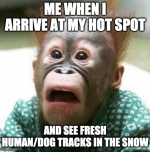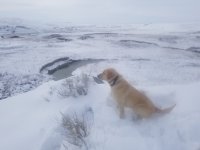Rogue Hunter
Active member
Not too experienced hunting pheasants. I was wondering how tactics change for you when hunting in the snow; or, when snow is expected, say, later the same day or expected the next day? thanks
I agree. In Montana , there is a lot of snow. They hit the thick cover.Be careful, those cricks are deep, and there is thin ice.Blast a hole in it, to check in spots.Phez hold better in snow. My ideal phez hunting day: 5" of new snow, overcast, 30 degrees, and a breeze always on the dogs nose. lol
This is true. I wish I knew whether they use a weather app, or if it's an instinctive thing. But if bad weather is eminent, they definitely fill up before hunkering down.When it comes to forecasted snow (if the meteorologist is correct), I have found that pheasants load up and sock themselves in to safely weather the storm.

What if there is 24 inches?We had a light snow cover the ground this morning and I was wishing A. I could have been in the duck blind this morning and B. Chasing pheasants this afternoon. Now that I think about it, I guess I'd like to do both regardless of weather. Anyhoo... Snow helps tremendously (especially this one, since its been so dry) when it comes to scenting as it keeps the dogs from breathing in so much dust, thus improving their ability to locate birds. As far as the pheasants go, their pattern will stay pretty much the same as it isn't a behavior altering amount.
When it comes to forecasted snow (if the meteorologist is correct), I have found that pheasants load up and sock themselves in to safely weather the storm. That said, if snow starts at 6:00pm, I like to hit the cattails or thermal habitat starting about 3:30pm or 4:00pm. If the snow doesn't start until later in the evening, it's kind of a wash. If cumulative amounts do fall (4" or more), I would really put my attention to the cattails. Unless I wasn't finding anything there, then I'd move outward.
Hunt like you normally would and make adjustments if the birds are tending to be in a particular type of habitat and focus on that.
Right, chili & sitting by the fire. Leave the birds alone (or go deliver them some corn), as they'll need all the help they can get.What if there is 24 inches?
What if there is 24 inches?
What if there is 24 inchesWe had a light snow cover the ground this morning and I was wishing A. I could have been in the duck blind this morning and B. Chasing pheasants this afternoon. Now that I think about it, I guess I'd like to do both regardless of weather. Anyhoo... Snow helps tremendously (especially this one, since its been so dry) when it comes to scenting as it keeps the dogs from breathing in so much dust, thus improving their ability to locate birds. As far as the pheasants go, their pattern will stay pretty much the same as it isn't a behavior altering amount.
When it comes to forecasted snow (if the meteorologist is correct), I have found that pheasants load up and sock themselves in to safely weather the storm. That said, if snow starts at 6:00pm, I like to hit the cattails or thermal habitat starting about 3:30pm or 4:00pm. If the snow doesn't start until later in the evening, it's kind of a wash. If cumulative amounts do fall (4" or more), I would really put my attention to the cattails. Unless I wasn't finding anything there, then I'd move outward.
Hunt like you normally would and make adjustments if the birds are tending to be in a particular type of habitat and focus on that.
In Montana, it isn't unusual to get deep snow, and below zero temps, for weeks on end.I hope this season is mild.If we receive 24 inches in one shot, I'm not going to bother the pheasants until they've had a day or two following the storm to load their crops and gizzards back up. Probably more than that.

most are new and never seen it before..."the sky is falling"I can tell you the very first accumulating snow of the year really bewilders the birds. You can see them all over the roads and acting bizarre.
